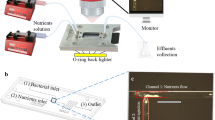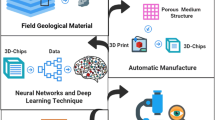Abstract
Fine particles within porous media may migrate with the flowing fluid and cause bridging or clogging in the pore space. Bridging and clogging reduce the flow permeability of porous media, which has a significant influence on petroleum engineering applications such as water and oil extraction, sand production, and gas production from hydrate-bearing sediments. Although the migration of fine particles and its impact on bridging and clogging have been investigated for a single-phase flow, it has not been understood clearly for a multi-phase flow. This work reports an approach using microfluidic pore models to study the migration of fine particles and the bridging/clogging behavior in a structure mimicking porous media. Results from the microfluidic model show that: (1) fine particles accumulated along the water and gas (CO2) interface; (2) fine particle concentrations in pores locally increased due to the accumulated particles at the interface, and (3) consequently bridging and clogging occurred in the pore throat. Findings from this work provide a starting point in understanding complex phenomena including a reduced flow permeability of porous media on a fluid containing fine particles for a variety of petroleum engineering applications.









Similar content being viewed by others
References
Agbangla GC et al (2012) Experimental investigation of pore clogging by microparticles: evidence for a critical flux density of particle yielding arches and deposits. Sep Purif Technol 101:42–48
Oyeneyin MB et al (1995) Factors to consider in the effective management and control of fines migration in high permeability sands. In: Society of Petroleum Engineers
Bigno Y et al (1994) Investigation of pore-blocking mechanism in gravel packs in the management and control of fines migration. SPE, Lafayette
Crist JT et al (2005) Transport and retention mechanisms of colloids in partially saturated porous media. Vadose Zone J 4:184–195
Datta S, Redner S (1998) Gradient clogging in depth filtration. Phys Rev E 58:R1203
Fan LT et al (1985) Analysis of deep bed filtration data: modelling as a birth–death process. AIChE 31(11):1781
Gruesbeck C, Collins E (1982) Entrainment and deposition of fine particles in porous media. Soc Petrol Eng J 22:847–856
Herzing JP et al (1970) Flow of suspensions through porous media—application to deep filtration. Flow Through Porous Media Symp 62(5):8–35
Imdakm AO, Sahami M (1991) Computer simulation of particle transport in flow through porous media. Chem Eng Sci 46:1977
Jain AK, Juanes R (2009) Preferential mode of gas invasion in sediments: grain-scale mechanistic model of coupled multiphase fluid flow and sediment mechanics. J Geophys Res 114(B8):B08101
Jung JW et al (2012) Gas production from hydrate-bearing sediments: the role of fine particles. Energy Fuels 26:480–487
Kampel G, Goldsztein GH (2008) Plugging in porous media: maximum clogged porosity and optimal filter topologies. Appl Phys Lett 92(8):084101
Khilar KC, Fogler HS (1987) Colloidally included fines migration in porous media. Rev Chem Eng 4(1&2):43–103
Khilar KC, Fogler HS (1998) Migration of Fines in porous media. Kluwer Academic Publishers, Dordrecht
Kim AY, Berg JC (2000) Fractal aggregation: scaling of fractal dimension with stability ratio. Langmuir 16:2101–2104
MacDonald JC, Whitesides GM (2002) Poly(dimethylsiloxane) as a material for fabricating microfluidic devices. Acc Chem Res 35(7):491–499
Mackie RI et al (1987) Dynamic modelling of deep bed filtration. AIChE 33:1761
Muecke TW (1979) Formation fines and factors controlling their movement in porous media. J Petrol Technol 31:144–150
Pandya VB et al (1998) Existence of a critical particle concentration in plugging of a packed bed. AIChE 44(4):978–981
Papamichos E et al (2001) Volumetric sand production model and experiment. Int J Numer Anal Methods Geomech 25(8):789–808
Rege SD, Fogler HS (1988) A network model for deep bed filtration of solid particles and emulsion drops. AIChE 34(11):1761
Sanderson SL et al (2001) Crossflow filtration in suspension-feeding fishes. Nature 412(6845):439–441
Sharma MM, Yortsos YC (1987) Fines migration in porour media. AIChE 33(10):1654–1662
Sherard JL et al (1984) Basic properties of sand and gravel filters. Geotech Eng 110(6):684–700
Shin H, Santamarina JC (2010) Fluid-driven fractures in uncemented sediments: underlying particle-level processes. Earth Planet Sci Lett 299:180–189
Valdes JR (2002) Fine migration and formation damage-microscale studies. Civil Engineering, Geoogia Institute of Technology. Doctor of Philosophy
Valdes JR, Santamarina JC (2008) Clogging: bridge formation and vibration-based destabilization. Can Geotech J 45(2):177–184
Wan J, Tokunaga TK (2002) Partitioning of clay colloids at air-water interfaces. J Colloid Interface Sci 247(1):54–61
Wan J, Wilson JL (1994) Colloid transport in unsaturated porous media. Water Resour Res 30(4):857–864
Wan J et al (2001) Generation of stable microbubbles and their transport through porous media. Water Resour Res 37(5):1173–1182
Acknowledgement
This research was made possible by NPRP Grant # NPRP8-594-2-244 from Qatar National Research Fund (a member of Qatar Foundation). The findings achieved herein are solely the responsibility of the authors.
Author information
Authors and Affiliations
Corresponding author
Rights and permissions
About this article
Cite this article
Jung, J., Cao, S.C., Shin, YH. et al. A microfluidic pore model to study the migration of fine particles in single-phase and multi-phase flows in porous media. Microsyst Technol 24, 1071–1080 (2018). https://doi.org/10.1007/s00542-017-3462-1
Received:
Accepted:
Published:
Issue Date:
DOI: https://doi.org/10.1007/s00542-017-3462-1




